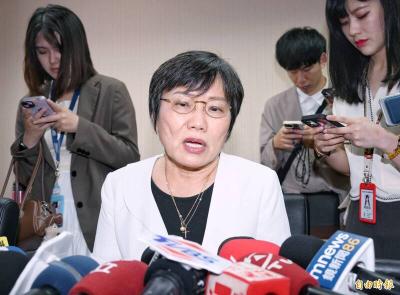Centers for Disease Control (CDC) spokesman Shih Wen-yi (施文儀) yesterday said that more communication between countries and government bodies is needed when dealing with swine flu cases.
“The earlier we can notify each other, the earlier we will be able to stop the disease,” Shih told a CDC press conference yesterday, referring to the 23 passengers who were on board a flight from St Paul, Minnesota, to Tokyo last Friday in which one Chinese patient was later confirmed as contracting H1N1, or swine flu.
The CDC said that the 23 passengers transferred in Tokyo and arrived in Taiwan on Friday. Among the four passengers who did not enter Taiwan, two of them transferred to Cambodia, one flew on to Macau and the other went to Hong Kong.
Shih said the CDC notified its counterparts in Cambodia, Macau and Hong Kong regarding the four passengers.
The CDC contacted 18 of the passengers on Monday night. The last one, however, was not located until yesterday morning.
“The last passenger is a foreigner. He did not check into the hotel he was planning to, so we spent quite some time finding him,” Shih said.
At 5:30pm yesterday, the CDC confirmed that all 19 passengers tested negative for swine flu.
Shih reminded the public about the CDC’s toll-free hotline, 1922, which is used for reporting suspected cases of flu or gaining useful information in fighting disease, especially swine flu. The spokesman encouraged locals to tell friends and relatives visiting from foreign countries about the hotline.
Also yesterday, a 53-year-old man with flu-like symptoms fled Taipei City Hospital’s Renai branch without completing the required tests to avoid being quarantined, the hospital said.
The man tested negative for the new H1N1 strain in the initial test, but he was required to complete two more tests to confirm he was not infected. He could face a fine of up to NT$60,000 if he refuses to follow hospital procedures, said Hsiao Sheng-huang (蕭勝煌), the medical director of the hospital.
Hsiao said the man was visiting the hospital yesterday for a regular hepatitis checkup when a doctor found that he had flu-like symptoms. Because he had recently returned from Miami, the doctor asked him to do three rounds of tests for the H1N1 virus in the fever clinic.
The man’s wife accompanied him to the hospital and was also asked to do the tests. The couple left the hospital soon after finishing the initial test because the man’s wife said they needed to run some errands before being quarantined if she or her husband tested positive, Hsiao said.
“His wife was nervous that they might need to be quarantined if they tested positive, so the couple left the hospital in the middle of the tests,” he said.
Hsiao said the hospital had alerted health authorities.
The CDC found the man later and asked him to return to the hospital to finish all the tests.
Meanwhile, the Ministry of Foreign Affairs yesterday downgraded the travel alert for Mexico from “red” to “orange” because the WHO said the severity of the H1N1 situation there had lessened.
Denmark, Switzerland, Ireland, Austria and Hong Kong were taken off the “yellow” travel alert by the Bureau of Consular Affairs and the Mainland Affairs Council because they had no new confirmed reports of the virus in the last seven days. However, Thailand, Cuba and Finland have been listed as “yellow” because they have confirmed cases of the virus.
ADDITIONAL REPORTING BY JENNY W. HSU

Chinese Nationalist Party (KMT) Chairman Eric Chu (朱立倫), spokeswoman Yang Chih-yu (楊智伃) and Legislator Hsieh Lung-chieh (謝龍介) would be summoned by police for questioning for leading an illegal assembly on Thursday evening last week, Minister of the Interior Liu Shyh-fang (劉世芳) said today. The three KMT officials led an assembly outside the Taipei City Prosecutors’ Office, a restricted area where public assembly is not allowed, protesting the questioning of several KMT staff and searches of KMT headquarters and offices in a recall petition forgery case. Chu, Yang and Hsieh are all suspected of contravening the Assembly and Parade Act (集會遊行法) by holding

PRAISE: Japanese visitor Takashi Kubota said the Taiwanese temple architecture images showcased in the AI Art Gallery were the most impressive displays he saw Taiwan does not have an official pavilion at the World Expo in Osaka, Japan, because of its diplomatic predicament, but the government-backed Tech World pavilion is drawing interest with its unique recreations of works by Taiwanese artists. The pavilion features an artificial intelligence (AI)-based art gallery showcasing works of famous Taiwanese artists from the Japanese colonial period using innovative technologies. Among its main simulated displays are Eastern gouache paintings by Chen Chin (陳進), Lin Yu-shan (林玉山) and Kuo Hsueh-hu (郭雪湖), who were the three young Taiwanese painters selected for the East Asian Painting exhibition in 1927. Gouache is a water-based

Taiwan would welcome the return of Honduras as a diplomatic ally if its next president decides to make such a move, Minister of Foreign Affairs Lin Chia-lung (林佳龍) said yesterday. “Of course, we would welcome Honduras if they want to restore diplomatic ties with Taiwan after their elections,” Lin said at a meeting of the legislature’s Foreign Affairs and National Defense Committee, when asked to comment on statements made by two of the three Honduran presidential candidates during the presidential campaign in the Central American country. Taiwan is paying close attention to the region as a whole in the wake of a

OFF-TARGET: More than 30,000 participants were expected to take part in the Games next month, but only 6,550 foreign and 19,400 Taiwanese athletes have registered Taipei city councilors yesterday blasted the organizers of next month’s World Masters Games over sudden timetable and venue changes, which they said have caused thousands of participants to back out of the international sporting event, among other organizational issues. They also cited visa delays and political interference by China as reasons many foreign athletes are requesting refunds for the event, to be held from May 17 to 30. Jointly organized by the Taipei and New Taipei City governments, the games have been rocked by numerous controversies since preparations began in 2020. Taipei City Councilor Lin Yen-feng (林延鳳) said yesterday that new measures by